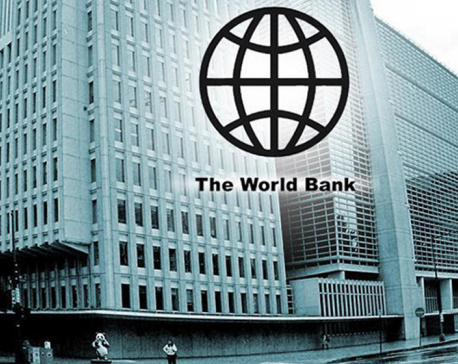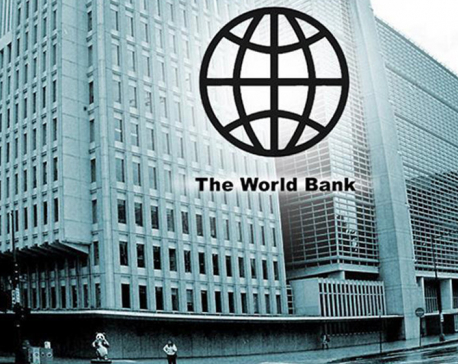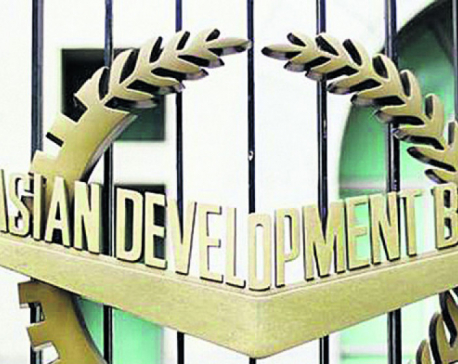
OR
World Bank projects a rebound in Nepal’s Economic Growth
Published On: October 6, 2023 10:30 AM NPT By: Republica | @RepublicaNepal

KATHMANDU, Oct 6: The World Bank (WB) has estimated expansion of Nepal's economic growth in the coming fiscal year.
Making public the South Asian Development Update and Nepal Development Update 2023 in Kathmandu on Thursday, the World Bank said Nepal's economy is expected to rebound to 3.9 % growth rate in the fiscal year 2024.
However, Nepal's Gross Domestic growth rate will remain at 1.9 percent this year, the World Bank noted.
In collaboration with Society of Economic Journalists Nepal (SEJON) and the Kathmandu University, the World Bank released the South Asian Development Update and Nepal Development Update reports.
The economy is expected to rebound owing to a lagged impact of the lifting of import restrictions, strong rebound in tourism, and the gradual loosening of monetary policy, according to the World Bank’s twice-a-year country update.
Nepal’s economy is estimated to grow by 5% in fiscal year 2025. However, there are multiple risks to the outlook including an erratic monsoon, which could dampen agricultural growth; a renewed spike in commodity prices or continued food export bans by India which would raise prices; and higher inflation which could keep policy rates elevated, increase domestic debt servicing costs, and drag on growth.
The country’s total exports amounted to 6.9% of GDP in FY 2023, representing only a third of the exports of other South Asian middle-income countries on average.
The analysis finds that the real appreciation of the exchange rate and continued low labor productivity are associated with Nepal’s lower exports. As per the report, Nepal suffers from labor productivity deficit across all three sectors – agriculture, industry, and services – compared to peer countries and its main trading partner, India.
“Amid challenges, Nepal is leading the way towards operationalizing its green, resilient, and inclusive development vision to shape the country’s long-term economic recovery,” said Faris Hadad-Zervos, World Bank Country Director for Maldives, Nepal, and Sri Lanka. “Improved external competitiveness is key to driving this recovery and enabling Nepal to compete in export markets, in terms of both prices and quality. This requires emphasis on reforms to help increase domestic productivity and reduce the inflation differential with Nepal’s trading partners.”
He noted that Nepal has higher economic potentials and expressed happiness over Nepal's preparation to graduate to the developing country status.
“South Asia’s energy intensity of output is about twice the global average and the region lags in the adoption of more advanced energy-efficient technologies,” said Franziska Ohnsorge, World Bank Chief Economist for South Asia. “Improvements in energy efficiency, in the context of a rapid global energy transition, are an opportunity for South Asia to make progress toward both environmental and economic goals.”
The Nepal Development Update is a companion piece to the latest South Asia Development Update, Toward Faster, Cleaner Growth, also launched today, which projects South Asia to grow by 5.8% this year—higher than any other developing country region in the world, but slower than its pre-pandemic pace and not fast enough to meet its development goals.
Regional growth prospects are subject to downside risks, including due to fragile fiscal positions. Government debt in South Asian countries averaged 86% of GDP in 2022, increasing the risks of defaults, raising borrowing costs, and diverting credit away from the private sector. The region could also be affected by a further slowdown in China’s economic growth and natural disasters made more frequent and intense by climate change.
Constrained by fiscal challenges, governments have limited room to help their economies fully capitalize on the global energy transition. Though often seen as an additional burden for developing countries, for South Asia, the energy transition could present an opportunity for future growth and job creation—if it leads to more investments by firms, cuts air pollution, and reduces the reliance on fuel imports.
The energy transition will also have significant impacts on South Asia’s labor markets. Almost one-tenth of the region’s workers are employed in pollution-intensive jobs. These jobs are concentrated among lower-skilled and informal workers who are more vulnerable to labor market shifts. While the energy transition can help create more new jobs, it could also leave some workers stranded in declining industries. The report recommends a wide range of policies to protect such workers, including providing better access to high-quality education and training, finance, and markets; facilitating worker mobility; and strengthening social safety nets.
Also on the occasion, presenting Nepal's updates, World Bank's economist Nayan Krishna Joshi said Nepal has made remarkable progress in every sector. Nepal has been exporting electricity to India and preparation for power export to Bangladesh would substantially help economic development.
Joshi shared that sluggish progress in retail and wholesale trade has slowed down the growth of service sector in 2023.
Average consumer price has reached the highest point in seven years in the year 2023, he said low import and high remittance inflow has dropped to the lowest level since six years.
Also speaking on the occasion, National Planning Commission member Dr Ramesh Chandra Poudel said coordination was not being made with productivity of Nepali school education, laying emphasis on reforming education system of Nepal.
(RSS)
You May Like This

WB projects Nepal's economic growth rate at 3.9 percent in 2024
KATHMANDU, Oct 3: The World Bank has projected Nepal's economic growth rate at 3.9 percent in 2024. In its latest... Read More...

Services-led growth key to Nepal’s green, resilient, and inclusive development: World Bank
KATHMANDU, Oct 7: The World Bank (WB) has projected that the Nepali economy will grow by 3.9 percent in the current... Read More...

ADB projects Nepal’s growth rate to remain at 3.9 percent in current FY
KATHMANDU, April 6: The Asian Development Bank (ADB) has projected a 3.9 percent economic growth rate for Nepal in the current... Read More...







Just In
- NRB to provide collateral-free loans to foreign employment seekers
- NEB to publish Grade 12 results next week
- Body handover begins; Relatives remain dissatisfied with insurance, compensation amount
- NC defers its plan to join Koshi govt
- NRB to review microfinance loan interest rate
- 134 dead in floods and landslides since onset of monsoon this year
- Mahakali Irrigation Project sees only 22 percent physical progress in 18 years
- Singapore now holds world's most powerful passport; Nepal stays at 98th











Leave A Comment